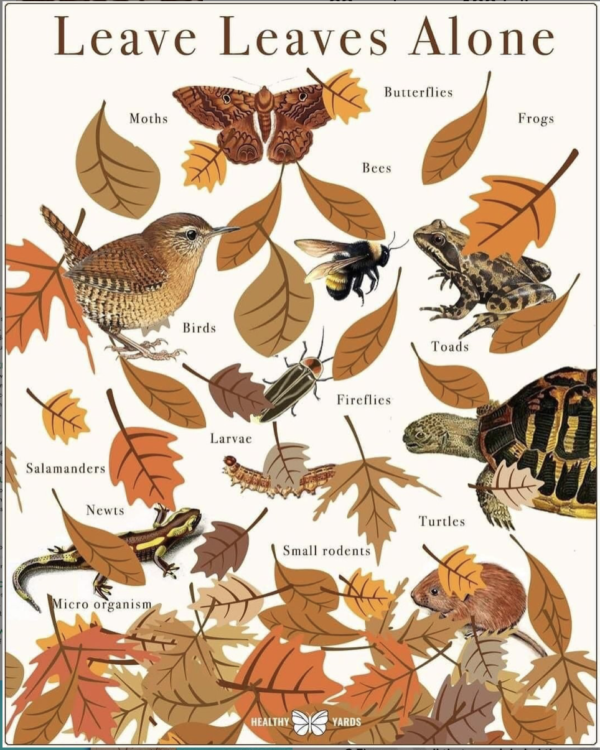Decolonize Your Lawn This Fall: Leave Leaves Alone
Editor’s Note: This information is shared courtesy of Leave Leaves Alone. Check out their website for more information, including the science, of how blowing leaves is unhealthy for you and your lawn. Enjoy your autumn in the Northern Hemisphere! Read more about the need to decolonize our bodies and earth in the new book Inflamed: Deep Medicine and the Anatomy of Injustice.
The annual ritual of raking, blowing, piling, and possibly bagging, costs each homeowner – or their landscaper – hours of time each fall. It also robs the yards of one of nature’s greatest resources: rich, natural compost. The practice of leaf blowing causes serious diesel and particulate matter pollution, especially with the 2-stroke backpack leaf blowers so commonly used in suburban backyards.
There are alternatives and they’ll save you time AND money!
A more sustainable way of managing leaves on lawns involves mulching or mulch-mowing. Mulching helps to limit the negative impacts associated with leaf blowers.
Mulching is easy to learn and easy to do whether a homeowner or professional.
More and more landscapers and homeowners are switching from blowing leaves to mulching them.
Mulch mowing can save municipalities (and taxpayers) tens of thousands of dollars, by avoiding the necessity of municipal collection.
PLEASE NOTE: Leaves are an important source for overwintering insects, and many butterflies. To encourage biodiversity in your yard and help insect populations, which are in serious decline, leave leaves wherever possible. Mulch the leaves on the lawn to avoid smothering the lawn, but leave leaves as they fall in perennial beds, under tree canopies, around shrubs, and on ground cover, like pachysandra.
Other Ways to Manage Leaves
Pile the Leaves
Not a fan of the mowing idea? Pile the leaves somewhere where they won’t be disturbed and leave them alone. It’s best to put them in a spot where they are not too sheltered, as the pile needs to get wet occasionally. After about two years or less, you’ll have rich, crumbly compost, about 1/20 the size of the original leaf pile, ready to add to your flower beds or around your shrubs. You don’t have to use the compost; you can just ignore it and leave it where it is. Raking leaves onto a tarp to move the leaves can be much more efficient than blowing leaves with a leaf blower across a yard. (This will eliminate annoying the neighbors with leaf blower noise and avoid generating toxic fumes and polluting the air with particulate matter.)
Shred Them
To make your pile of leaves decompose more quickly, you can shred the leaves with either a leaf shredder, or a chipper/shredder, which is more expensive, but able to also handle twigs and small branches. You can also pass over leaves with a lawn mower, or put them in a garbage bin and mulch them with a weed whacker. This is really good when you don’t have much space as it will reduce the volume of your leaf pile to about one tenth of its original size. Shredding leaves this way speeds up decomposition: if you do this in the fall, you can expect to have compost by mid-summer the following year.
Contain Them
So you like things to be nice and tidy? No problem. Build a container and compost the leaves. A ring of chicken wire is the simplest leaf container but any containment system works as long as the leaves are exposed to air and water. A container stops the leaves from blowing around and they will slowly decompose and turn into compost. When it’s ready, remove the compost and use it in your garden and wait for the next fall to top up the container.
Vacuum Them
Suitable for small areas, leaf vacuums allow you to gather the leaves and shred them at the same time. Add them to a compost pile, or place them onto perennial beds and around shrubs as protective mulch. This mulch decomposes and enriches the soil.
Use Them As Insulation
You can shred the leaves into small pieces and place them on your flower beds as mulch for winter protection. Or, even better, don’t shred them and just leave them on the flower or vegetable garden beds for the winter. If they haven’t broken down by spring, remove them (piling them in a compost pile) to allow any tender plants to emerge or leave them and they’ll keep weeds down in the growing season. (If you have very tender perennials, which will have trouble emerging through a heavy leaf layer, the leaves will need to be moved. But many tougher perennials just emerge through a light leaf layer with no trouble.)
How to Use Compost
Compost enriches soil — it’s like vitamins, combined with pre- and probiotics for the soil. You can add it to flower and vegetable beds, plant pots, window boxes, around shrubs and trees and as enrichment to grass lawns. More details here.
Toss Them In the Woods
Although it’s better to mulch your leaves, and leave the chopped up leaves on your lawn and flower beds so they can enrich your soil, you can just rake or blow your leaves into the woods – if you have woods. (Be sure not the pile the leaves too deep around the tree trunks in the woods, so spread them around. Too thick a leaf layer may also smother understory trees.) The trees, from which the leaves fell, will thank you as their soil is nourished by the decomposing leaves breaking down into compost, just as nature intended. Please note that using a leaf blower in garden beds is very destructive to topsoil and bad for plants. It is best to remove leaves from flower beds by hand or with a rake.


